
Membrane Aerated Biofilm Reactor (MABR) Intensification in a Warm Climate - Live Webinar
Recorded On: 06/04/2024
- Registration Closed

CWEA Members: $25.00
Non-Members: $35.00
1.2 Contact Hours Towards CWEA Certifications: AWTO
The membrane aerated biofilm reactor (MABR) process is an emerging activated sludge intensification technology that has received much interest in the wastewater industry. MABRs include a biofilm with high concentrations of nitrifiers. The biofilm removes a portion of the influent ammonia, and sloughed biomass seeds the activated sludge process with nitrifiers. This allows the activated sludge process to be operated at a lower sludge retention time (SRT) which translates to more capacity. Capacity benefits are more significant in cold weather applications where long SRTs are typically needed for reliable nutrient removal. Given the limited full-scale operating experience, technology evaluation and design must rely on pilot and modeling results.
The Sanitation Districts recently conducted a successful MABR pilot (Mansell et al 2022); however, due to mechanical issues, the pilot could not be operated at low SRTs to confirm performance and capacity benefits. Due to the warm climate, steady-state modeling indicates that CAS can achieve similar nitrogen removal as MABRs at aerobic SRTs as low as 3 days. It also shows reliable MABR performance at aerobic SRTs as low as 2 days. Steady-state modeling typically predicts better performance than what is experienced with the day-to-day variability of real treatment plants. To better quantify the performance and capacity benefits of warm weather operation at low SRTs, year-long dynamic modeling simulations are performed over a range of operating conditions for CAS and MABR. Frequency distributions for effluent performance and nitrifying biomass are developed to establish target SRTs that achieve comparable performance, reliability, and risk for CAS and MABR processes. This evaluation will help support the Sanitation District’s decision-making for upgrades at LCWRP.
• Learning Objectives/Attendee Takeaways:
No. 1: MABR Technology for Capacity Enhancement: MABR technology intensifies activated sludge processes by efficiently removing ammonia and seeding activated sludge with nitrifiers, increasing capacity, especially in cold weather.
No. 2: Evaluation at LCWRP: LCWRP is considering MABR for future capacity and treatment enhancement. Modeling suggests that MABRs can achieve similar nitrogen removal as conventional methods at lower SRTs in warm climates, with reliable performance.
No. 3: Dynamic Modeling for Decision Support: Dynamic modeling over a year-long period helps quantify performance and capacity benefits, aiding in establishing target SRTs for comparable performance and reliability between CAS and MABR processes. This supports decision-making for plant upgrades at LCWRP.
Andre Gharagozian (he/him/his)
Associate Vice President
Carollo Engineers
Andre Gharagozian is an Associate Vice President at Carollo and serves as the regional process lead for wastewater in northern California. He has over 25 years of experience and is a seasoned process engineer with a wide range of experience from facility and master planning, process analysis and design, troubleshooting, operational assistance, and training. Andre’s expertise is in process modeling and nitrogen removal with an emphasis on activated sludge, hybrid systems, and sidestream treatment.
Komal Rathore
Staff Professional
Carollo Engineers
Komal is a process engineer at Carollo with 7 years of experience. Since joining Carollo she has supported several projects involving master planning, process modeling, and various evaluation studies. She also has prior experience in applied research deploying mechanistic models for advanced decision making at wastewater treatment facilities. Her expertise includes dynamic process modeling of both established and emerging technologies as well as developing systematic process modeling frameworks.
Ziad El Jack
Supervising Engineer
Los Angeles County Sanitation Districts
Ziad ElJack is a Supervising Engineer with the Wastewater Planning Section of the Los Angeles County Sanitation Districts. His 25+ years of experience includes the research, planning, permitting, and design of related environmental control systems for wastewater and solid waste resource facilities, as well as international experience in the environmental planning and permitting of major infrastructure projects.
Rajesh Doppalapudi, P.E. (Moderator)
Southern California Regional Wastewater
Carollo Engineers
Rajesh Doppalapudi is Sr. Project Manager at Carollo and serves as the regional process lead for wastewater in southern California. He has over 23 years of experience and is a seasoned design engineer with a wide range of experience from facility and master planning to final design, construction, training, and operations assistance of wastewater treatment plants.
Registrants who view the live webinar to see the slides and hear the audio and then enter the correct attention check code (directions below) will receive 1.2 contact hours towards CWEA's certification: AWTO
To receive your contact hours for viewing the live webinar, please note the two (2) different attention check codes that will be displayed at two different points during the webinar in the top left or right corner of the presentation for approximately 90 seconds. Please enter these codes as 1st attention check code – 2nd attention check code (XXXX-XXXX) in the Attention Check Code component under the "Contents" tab.
Please note, all user activity of CWEA certification holders on the Online Wastewater Education Network is subject to the CWEA Code of Ethics standards for professional conduct and ethics. Certification holders should receive credit for a training only once within the same contact hour period. Any attempt to undermine the certification process may be subject to ethics procedures and possible sanctions. It is not possible to receive contact hours for both attending the live webinar and viewing the recording.
Once you have entered the correct attendance check codes, you will be able to create and download an electronic certificate of completion under the "Contents" tab.

